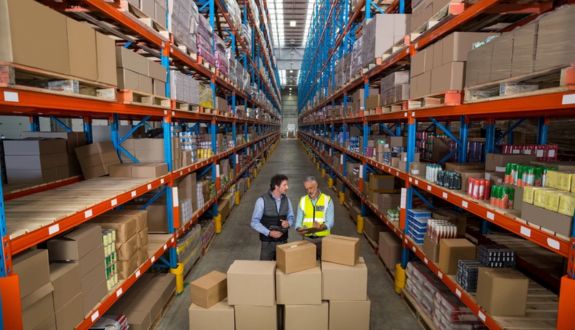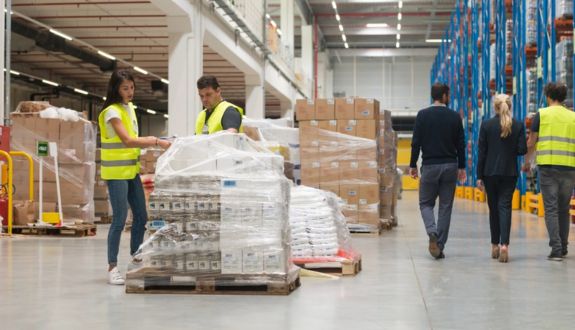Order Consolidation is the ability to bring together all the merchandise of an order with multiple products into one single shippable package is done for E-Commerce orders, or multiple packages for one order shipped at the same time in B2B or Retail fulfillment. Bringing the complete multi-product order into one single package to be shipped means saving on packaging, delivery, and is what most customers expect when placing an order.
Omnichannel retail makes order consolidation much more challenging. A significant advantage of the omnichannel strategy is that a robust order management system can optimally find and fulfill orders with merchandise from in-store inventory.
Smaller distributors should consider using pick-and-pass technology to reduce or eliminate the need for post-pick consolidation, but instead emphasize ensuring the entirety of an order leaves the facility on the same day. In this way the distributor can leverage the enormous investments UPS and FedEx have in their sortation solutions. In effect, the distributor is using a free Order Consolidation solution.
Furthermore, smaller distributors cannot afford to split-ship orders in most cases so they must seek out highly efficient cost-effective consolidation solutions.
Ascent Warehouse Logistics’ software offers many applications that provide order staging and buffering, with automated or semi-automated pulling of completed orders.
When consolidation must be done, Ascent Warehouse Logistics offers a multitude of solutions to bring orders together post-pick. From the simplest put wall or flow rack using lights or mobile devices, to highly automated storage solutions using any nearly every hardware solution on the market where the hardware is used for storing cartons, totes or containers for delayed shipping, or same day, when each order is completed.
Order consolidation is the physical aggregation of so that they can be kept in a staging area. For example, a kit can have parts coming from a variety of different areas, and those components are typically picked into some kind of a tote with a license plate identifier. Order consolidation is commonly guided by some kind of automation, such as put by light (i.e., put wall), put by mobile device, or put into a carousel system.
Staging is the accumulation of the goods or parts until the order is completed and it is pulled. Staging may involve different staging locations, as well as different types of automation, such as flow rack, shelving, carousels, and standard racking. In some cases, the staged parts are inducted and pulled with only a mobile device or inducted with a mobile device and pulled with light-directed operations. In other cases, the parts are staged using a hybrid solution that involves a horizontal carousel, vertical carousel, or vertical lift module (VLM).
Buffering refers to the process for joining up the picks from different zones or areas of a warehouse to complete the entire order or work order. Buffering is also referred to as an order buffering system, put wall, consolidation system, etc.
Order consolidation, staging, and buffering capabilities are important for distributors and manufacturers with high volume and high SKU count of goods or parts, where picking occurs in multiple areas and it is not practical to perform traditional pick and pass. These warehouses and distribution centers rely on parallel picking, where all the component parts of orders must be brought together from different areas within the warehouse or distribution center, and then staged prior to preparation for packing, shipping, and/or truck loading. Without a system to direct and automate order consolidation, staging, and buffering, these processes can be slow, error-prone, and labor intensive.

Automation optimizes order consolidation, staging, and buffering
Manual identification of parts or goods from various areas is time-consuming and prone to error. The process can be automated with some form of pick to tote or license plate identifier to identify what’s been picked in a particular area. Automation like this typically requires a warehouse execution system (WES) or warehouse control system (WCS) to manage the process and control the associated automation. The WES/WCS manages the manual or automated storage system used to actually perform the staging, buffering, and then the pulling process.
Automating order consolidation, staging, and buffering can improve warehouse throughput and reduce labor. After the component parts of the orders are picked there is usually a very narrow window of time for them to be assembled for shipment and/or truck loading. If automation is not used for order consolidation then large amounts of peak labor need to be applied. It is very difficult to balance these workloads because the labor tends to be needed in a huge spike towards the end of the shift.
The best software solutions for order consolidation, staging, and buffering
Enterprise resource planning (ERP) systems and ERP warehouse management software (WMS) modules, such as SAP and Oracle, rarely handle order consolidation, staging, and buffering processes well. They also do not handle any process automation, whether it is put and pull by light or any form of vertical or horizontal carousel solution.
A warehouse execution system (WES) or warehouse control system (WCS) software solution manages not only the communication to light directed operations and/or carousels, but also the workflow and process improvement functionality to identify all the different component parts from the various areas in an automated fashion, without slow and cumbersome manual verification. A WES or WCS can pull all of these functions together and seamlessly integrate them with automation, such as put and pull by light, horizontal carousels, vertical carousels, vertical lift modules (VLMs).
